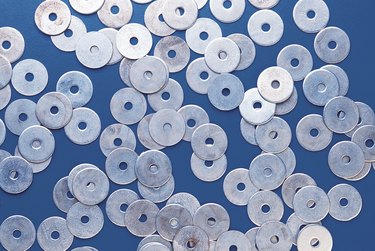
Spring washers are used in mechanical assemblies where fasteners might be loosened by vibration. These washers provide a constant pressure on the bolt and nut, keeping them tensioned and tight. Spring washers also provide the ability for assemblies to handle shock loads.
Spring Washer Considerations
Video of the Day
The differing uses for spring washers will determine which of the several types is the best to use. The first consideration is physical size, followed by workload. The size is the first concern because you'll need to know the outside diameter, hole size and thickness you need. After those factors are known, you can specify a spring washer that is rated for the load that will be placed on it by your equipment and the bolt and nut. Spring washers made of different materials such as stainless steel, nickel alloy steel and copper alloys also are available.
Video of the Day
Types of Spring Washers
Several different types of spring washers exist. They are the Belleville washer, which is a round spring compacted to a dish shape before hardening and tempering; the wave washer, which is a wavy, flat disc; the conical washer, which is designed as a high load-bearing washer; the curved washer, which is used to provide take-up of end play, also known as axial play, in assemblies; constant-force washers, which are adjustable spacers; or finger washers, which have fingers around the outside diameter which by design remove some load from the inner diameter of the washer and place it on the outside fingers.
Spring Washer Installation
Spring washers are installed in an assembly the same way a regular flat washer is used; the washer is added under the nut during component assembly, and the nut is tightened to a specified torque. This pre-loads the spring washer to its correct load rating.